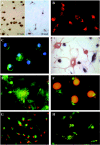Role of microglia in central nervous system infections
- PMID: 15489356
- PMCID: PMC523558
- DOI: 10.1128/CMR.17.4.942-964.2004
Role of microglia in central nervous system infections
Abstract
The nature of microglia fascinated many prominent researchers in the 19th and early 20th centuries, and in a classic treatise in 1932, Pio del Rio-Hortega formulated a number of concepts regarding the function of these resident macrophages of the brain parenchyma that remain relevant to this day. However, a renaissance of interest in microglia occurred toward the end of the 20th century, fueled by the recognition of their role in neuropathogenesis of infectious agents, such as human immunodeficiency virus type 1, and by what appears to be their participation in other neurodegenerative and neuroinflammatory disorders. During the same period, insights into the physiological and pathological properties of microglia were gained from in vivo and in vitro studies of neurotropic viruses, bacteria, fungi, parasites, and prions, which are reviewed in this article. New concepts that have emerged from these studies include the importance of cytokines and chemokines produced by activated microglia in neurodegenerative and neuroprotective processes and the elegant but astonishingly complex interactions between microglia, astrocytes, lymphocytes, and neurons that underlie these processes. It is proposed that an enhanced understanding of microglia will yield improved therapies of central nervous system infections, since such therapies are, by and large, sorely needed.
Figures

References
-
- Adamson, D. C., B. Wildemann, M. Sasaki, J. D. Glass, J. C. McArthur, V. I. Christov, T. M. Dawson, and V. L. Dawson. 1996. Immunologic NO synthase: elevation in severe AIDS dementia and induction by HIV-1 gp41. Science 274:1917-1921. - PubMed
-
- Adle-Biassette, H., F. Chretien, L. Wingertsmann, C. Hery, T. Ereau, F. Scaravilli, M. Tardieu, and F. Gray. 1999. Neuronal apoptosis does not correlate with dementia in HIV infection but is related to microglial activation and axonal damage. Neuropathol. Appl. Neurobiol. 25:123-133. - PubMed
-
- Aguirre, K., and S. Miller. 2002. MHC class II-positive perivascular microglial cells mediate resistance to Cryptococcus neoformans brain infection. Glia 39:184-188. - PubMed
-
- Ajmone-Cat, M. A., A. Nicolini, and L. Minghetti. 2003. Prolonged exposure of microglia to lipopolysaccharide modifies the intracellular signaling pathways and selectively promotes prostaglandin E2 synthesis. J. Neurochem. 87:1193-1203. - PubMed
-
- Albright, A. V., I. Frank, and F. Gonzalez-Scarano. 1999. Interleukin-2 treatment of microglia has no effect on in vitro HIV infection. AIDS 13:527-528. - PubMed
Publication types
MeSH terms
Grants and funding
LinkOut - more resources
Full Text Sources
Other Literature Sources

